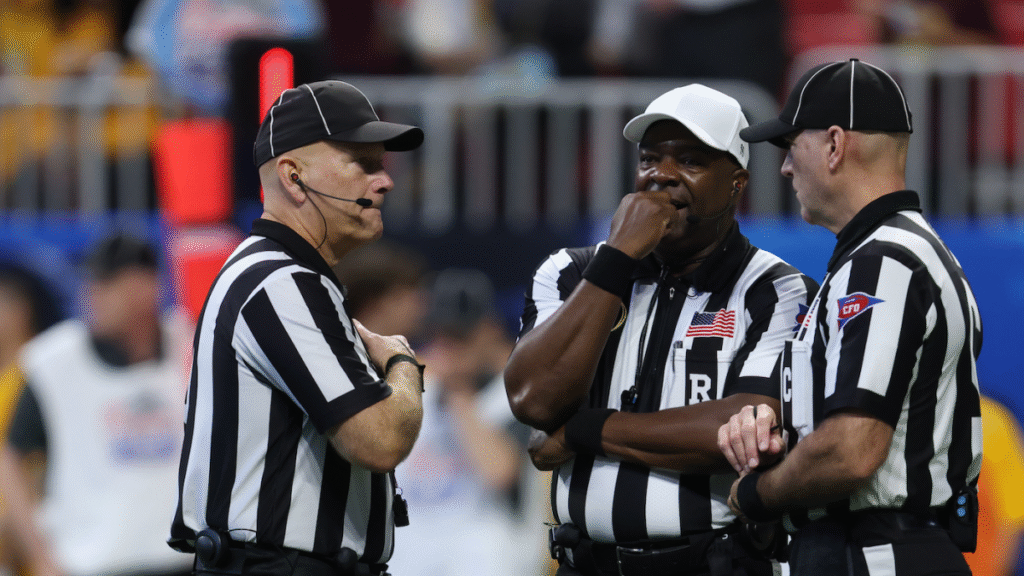In an effort to clean up a few troubling areas and persistent complaints within the sport, there’s more than a half-dozen significant rules changes going into effect for college football’s 2025 season. Many are injury-focused, while a few relate to player conduct and updated policies to better police the game.
Steve Shaw, the NCAA secretary-rules editor, recently announced the rules alterations in connection with the National Football Foundation (NFF) and College Hall of Fame through a partnership with College Football Officiating.
“The mission of the Rules Committee is to develop and evaluate rules changes that will enhance the sport, protect the image of the game, and enhance the student athlete’s health and safety,” Shaw said in a release this month. “Player safety has been the highest priority of the committee for many years now resulting in significant changes that have improved the game in terms of mitigating injuries.”
Here are the primary rule changes that will take effect in FBS play this season beginning with Saturday’s opener in Dublin, Ireland featuring Iowa State and Kansas State.
SEC expert picks 2025: Most overrated and underrated teams, projected order of finish, bold predictions
Brandon Marcello
Unsportsmanlike conduct for gunplay
A troubling celebration trend last season — players mimicking firing a weapon — has been banned. The NCAA will now issue an automatic 15-yard unsportsmanlike conduct penalty for simulation of “brandishing a weapon,” which includes pretending to fire a gun, rifle, crossbow or other device.
The tipping point came after South Carolina freshman edge rusher Dylan Stewart stood over Ole Miss quarterback Jaxson Dart and simulated gunplay. Stewart later called the moment “blown out of proportion,” but coach Shane Beamer denounced the act as “unacceptable” and disciplined him internally.
Fake injuries reprimanded
Citing an “inflection point” for the sport, Shaw said something had to be done about players faking injuries to slow tempo offenses. Beginning this season, if a player presents as injured after the ball is spotted, the team will be charged a timeout. If no timeouts are available, it results in a delay of game penalty. The player must sit out the following down, regardless of whether a timeout is taken.
The player cannot return until cleared by medical personnel designated by the school. The move follows repeated complaints about “flopping” to manipulate pace of play — including a memo from SEC commissioner Greg Sankey last fall.
Overtime timeouts
Timeouts are now limited in overtime. Each team gets one timeout in the first and second overtimes, but beginning with the third extra period, only one total timeout per team is allowed until the game ends. In addition, no media timeouts will be taken during the first two overtimes.
Signal changes during returns
On kickoffs, if any return-team player makes a “T” signal with their arms, the play is immediately whistled dead and the team forfeits the right to return. The clarification follows controversy in last year’s South Carolina–Illinois bowl game, where players used the gesture to indicate a fair catch.
Disconcerting signs, pre-snap movement
Defenses are now prohibited from using signals or words that mimic a quarterback’s cadence. A quarterback can clap to initiate a play, but no defender may do so or otherwise simulate a snap count.
Defensive players within one yard of the line are also prohibited from making abrupt pre-snap movements designed to draw a false start. Likewise, offensive players who attempt to bait the defense with sudden motion will be flagged for a false start.
Defensive substitution fouls
The committee closed a loophole exploited last year by Oregon coach Dan Lanning, who intentionally left too many players on the field in the final seconds of a win over Ohio State to bleed clock.
Starting this season, substitution infractions are treated as live-ball fouls. If committed inside the final two minutes of a half, the offense may reset the clock to the time displayed at the snap in addition to gaining 5 yards.
Tablets, vision shields and defenseless players
Coaches can continue using sideline tablets, but with stricter limits. Devices may only be interconnected to larger displays inside the locker room at halftime or during weather delays. Play sheets, analytics and other data cannot be uploaded.
Players are now restricted to clear visors only; tinted or multi-color shields are banned. Approved clear versions from Nike and Oakley are already in circulation.
Finally, the definition of a defenseless player has been expanded to include anyone pursuing a loose ball. In those situations, opponents must play the football directly — not target other players to gain position — or risk a 15-yard penalty.
Read the full article here



